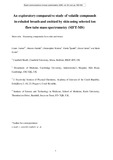- CERES Home
- →
- Cranfield Health
- →
- Staff publications - Cranfield Health
- →
- View Item
JavaScript is disabled for your browser. Some features of this site may not work without it.
| dc.contributor.author | Turner, Claire | - |
| dc.contributor.author | Parekh, Bhavin | - |
| dc.contributor.author | Walton, Christopher | - |
| dc.contributor.author | Španěl, Patrik | - |
| dc.contributor.author | Smith, David | - |
| dc.contributor.author | Evans, Mark | - |
| dc.date.accessioned | 2011-10-11T07:35:20Z | |
| dc.date.available | 2011-10-11T07:35:20Z | |
| dc.date.issued | 2008-01-01T00:00:00Z | - |
| dc.identifier.citation | Claire Turner, Bhavin Parekh, Christopher Walton, Patrik Španěl, David Smith and Mark Evans, An exploratory comparative study of volatile compounds in exhaled breath and emitted by skin using selected ion flow tube mass spectrometry, Rapid communications in mass spectrometry, 2008, vol. 22, no4, pp. 526-532 | - |
| dc.identifier.issn | 0951-4198 | - |
| dc.identifier.uri | http://dspace.lib.cranfield.ac.uk/handle/1826/4110 | |
| dc.description.abstract | This study examined the utilization patterns of key Carbon sources (CS, 24: including key sugars, aminoacids and fatty acids) in maize by strains of Aspergillus flavus and Fusarium verticillioides under different water activity (aw, 0.87-0.98 aw) and temperature (20-35°C) values and compared the niche overlap indices (NOI) that estimate the in vitro carbon source utilization profiles (Wilson and Lindow, 1994). The ability to grow in these key CS in minimal media was studied for 120 hrs in 12 hr steps. The NOI was calculated for inter-species (F. verticillioides – A. flavus) and for intra-species (A. flavus - A. flavus) using CS utilisation patterns over the range of interacting environmental conditions. 30°C, over the whole aw range examined, was found to be optimal for utilization of the maximum number of CS by A. flavus. In contrast, for F. verticillioides this was more so at 20°C; 25°C allowed a suboptimal usage of CS for both species. NOIs confirmed the nutritional dominance of A. flavus at 30°C, especially at lower aw levels and that of F. verticillioides at 20°C, mainly at 0.95 aw. In other conditions of aw, based on CS utilization patterns, the data indicated that A. flavus and F. verticillioides occupied different ecological niches. The variability in nutritional sources utilization between A. flavus strains was not related to their ability to produce aflatoxins (AFs). This type of data helps to explain the nutritional dominance of fungal species and strains under different environmental conditions. This could be useful in trying to find appropriate natural biocontrol microorganisms to compete with these mycotoxigenic | en_UK |
| dc.language.iso | en_UK | - |
| dc.publisher | John Wiley & Sons, Ltd | en_UK |
| dc.title | An exploratory comparative study of volatile compounds in exhaled breath and emitted by skin using selected ion flow tube mass spectrometry | en_UK |
| dc.type | Article | - |
